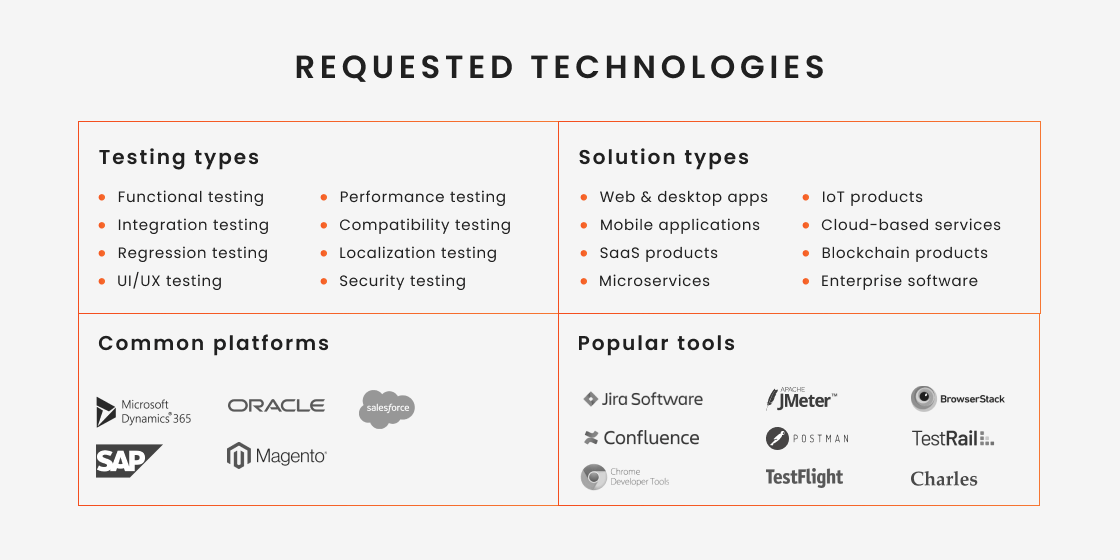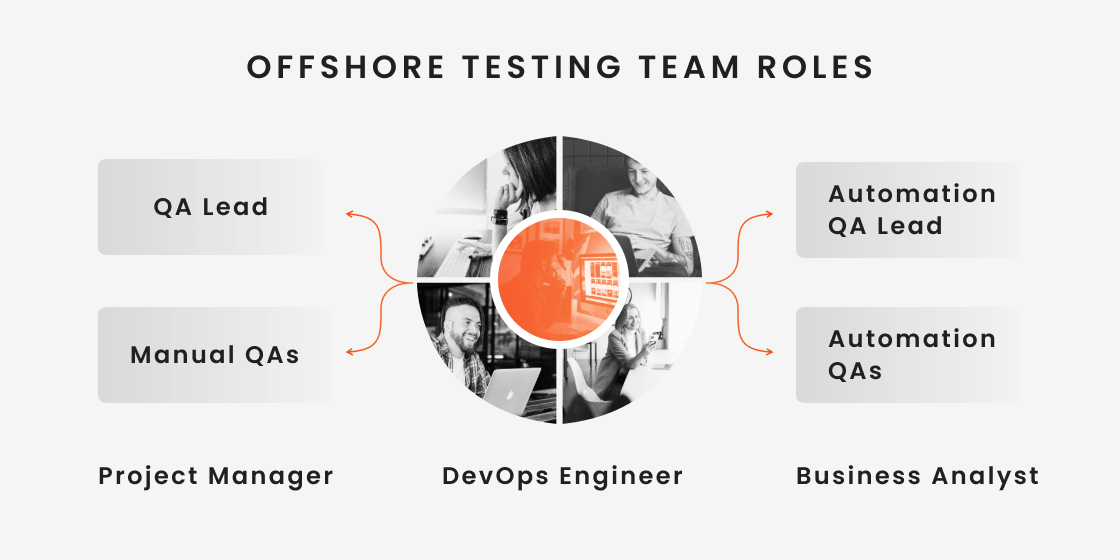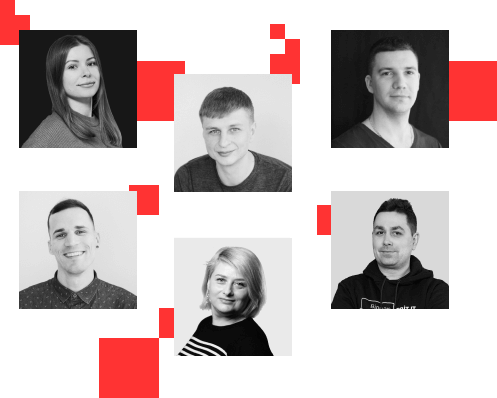Assembling the perfect software testing offshore team: Structure and responsibilities
Building an offshore quality assurance team is one of the most fundamental decision in the whole process. It can get even more challenging than regular hiring because you don’t get to meet the prospective candidates in real life and need to only rely on their CVs and video interviews to make the decision. Still, deciding who to hire and for which roles is something that will have a lasting effect on the whole project.
There are no universal standards when it comes offshore teams because it all depends on the size and complexity of the project, its anticipated duration, as well as the already available testing resources. In case you are planning to entrust the entire scope of testing to an offshore team, its composition will typically include the following roles:
- Manual QAs — these are specialists who do the biggest chunk of the work on a typical testing project. Manual QAs can get to work almost immediately without a lengthy preparation period. A medium-sized QA project is going to lead 3 to 5 manual QAs.
- QA Lead — a person who is in charge of managing the manual QA team. In some cases, the role of a Manual QA Lead is filled by a Senior-level member of the team; in that case, the Lead not only manages the team and communicates with the client, but also does hands-on testing work.
- Automation QAs — essential specialists for any mid-sized to large testing project, especially one with a lot of tests that are run repeatedly, such as regression tests. The automation team typically comes on board after the manual team has already completed a portion of work, although sometimes Automation QAs can start simultaneously with the Manual QAs in case there are some tests completed already — for example, by a previous QA team.
- Automation QA Lead — an engineer who oversees the work of the Automation QA team and participates in various testing tasks. A common scenario is when the Automation Lead joins the project before the rest of the team, so that, by the time other Automation QAs begin working on the project, there is already a solid foundation for their next steps.
- Project Manager — a vital specialist that acts as the link between the client and the vendor. The PM can operate on the vendor’s side, but that only makes sense in case of a large project that involves services besides testing. For most testing projects, a Project Manager working on the client’s side is the most fitting setup.
- DevOps Engineer — a specialist responsible for creating the infrastructure for a project and making sure the development and testing departments have everything needed to work efficiently and without interruptions. The Devops Engineer can work on the client’s side, but it can be a big advantage in favor of the vendor when they have their own DevOps department ready to take over all related tasks.
- Business Analyst — a person who uses various ways to source business data and insights to then suggest ways for an organization to move forward in terms of business success. The work of a Business Analyst is directly linked to high-quality software produced by an organization, which is why a BA being involved in a testing project, at least in a part-time role, is a strong advantage.
In addition to that, the presence of the development team is integral for a successful start of a QA project and for achieving the desired results. Otherwise, the client risks hiring an offshore testing team only for them to run the initial tests and then have nothing much else to do because there is no one to fix the bugs. Many companies thrive by working with two offshore teams — one for development, and the other one for testing — or having the development team operate in-house. In any case, it’s up to the client to ensure smooth cooperation between all departments to avoid bottlenecks within the project.
Software QA tech stack: Most popular services
One of the main reasons why more and companies now prefer to use offshore software testing services is that with offshoring, it’s possible to work with niche experts you cannot always easily hire locally. And that expertise includes not only specific domain experience, but also familiarity with certain technologies. It’s very common for in-house teams to only work with a limited number of technologies, and getting your team to master those technologies takes time and money, which makes it not the most financially feasible option.
Luckily, an offshore team for testing software meets even the most unusual requirements in terms of types of testing, technologies, and latest tools you want to use on the project. Here are the technologies often requested by clients.
How to find the right offshore software testing partner
Whether you need a team for a small, limited-time task, or you are planning long-term collaboration with the same vendor, the choice of an offshore partner is one of the most fundamental ones you’ll have to make. A team selected for the wrong reasons, or with barely any selection process at all, may not deliver the results you expect, and the likelihood of facing common issues and obstacles increases. Here is how to choose a partner for a fruitful and mutually satisfying QA cooperation.
1. Get clear on the requirements
The first and one of the most crucial steps to a fruitful offshore collaboration is to achieve full clarity and internal agreement on the project requirements. Specifically, you need to know which services you need from the vendor, on what scale, and for how long. You may also have extra requirements when it comes to the domain expertise or unique skills of the team. Finally, you should know how many team members you need, at least an approximate number — a small vendor may simply not have enough available resources for a large project, and hiring multiple new specialists in limited time isn’t always an option. A vendor with 150 or more specialists on board will usually be able to quickly assemble a QA team of any size.
1. Research the skills and services
This one’s simple: decide which tasks exactly you need the offshore team to handle and whether they have the capacity to do so. It’s important to know from the start whether you are looking for just one team to handle the entire massive of tasks, or you have the financial and management ability to work with multiple teams. When going for the first option, it’s vital to reach an agreement on what your team can and cannot do for you. It’s definitely more financially feasible to work with just one team, but sometimes, when you need rare services and technical expertise, you need to use extra help from another vendor. Also, make sure that the vendor’s claims to possess certain skills and experience are backed up by relevant portfolio entries.
3. Review the project portfolio
Any reputable offshore QA company that has been in the market for some time must have a portfolio of projects — after all, it’s often the only way to evaluate the vendor’s experience and grasp of relevant technologies and testing techniques. The cases in the portfolio will typically contain information on which services were delivered, over which period of time, as well as the size and composition of the team. Ideally, the case study also has to contain information on the client’s industry and type of product, so that you could find previous works most relevant to your own situation. A detailed project portfolio will give you information not only on what the company can do, but also on how exactly it does it.
4. Discuss the cooperation options
Offshore testing companies usually offer a selection of cooperation models that fit the needs of most clients. Most vendors provide the following minimum of models:
- Fixed cost — where the cost of the project is known from the start after extensive calculations and changes are typically not allowed after the project begins.
- Time and material — where you can benefit from flexible requirements and change the scope and scale of the project as you go, paying for the time of all employees involved in the project.
- Dedicated team — where you can assemble an entire team of QA engineers and other specialists, and work with them for as long as you need, not necessarily tying the cooperation to just one project.
Additionally, many vendors offer a fourth model, called hybrid or fixed cost plus. During the initial consultations, the vendor can recommend you the most suitable model for your project requirements. Still, at the end of the day, it’s your choice to make, and the vendor needs to show understanding and flexibility.
5. Ask about communication practices
Since you and your offshore team are not going to share an office, and it’s very unlikely that you’ll ever work from the same premises throughout your entire collaboration, you will need to rely on various communication methods to ensure a smooth workflow. Therefore, it’s important to make sure that you and your team are on the same page in terms of communication channels, sync-up schedules, hours of availability for a chat or call, and other communication parameters you find important. You can usually expect the vendor to adapt to your communication practices — for example, by using specific tools for chats and calls.
6. Consider time zone and language differences
Time and language differences are a common issue companies face when offshoring their QA needs, and while they can usually be mitigated with proper management and open communication, these difference turn out to be dealbreakers for some companies. At the very least, you need to make sure that the team has at least some working proficiency in English and a strategy to improve their language skills in case they are lacking. As for the time zones, the solutions can be different: in case of a large difference, some vendors are even prepared to alter their schedule to make sure that at least a few hours of their workday overlap with the client’s.
7. Evaluate the work ethic
This is something that is hard to fully gauge before the start of the project, but you can still catch glimpses of the team’s work ethic while preparing for the collaboration. For example, pay attention to how long it takes for the manager to reply to your questions, and how complete their answers are. And keep in mind that at this stage, the vendor is still trying to win you over, so if the responsible team members take hours to reply and their replies cannot be called complete, things can further change for the worse once you start working together. It’s also a good idea to research the company online to find reviews from former clients that the company didn’t publish on their own site.
How to make the most of your offshore testing team
When you hire offshore testing team, the choice of a vendor and the composition of the team are obviously important, as is the scope of work you plan to hand over to the new team. However, when using offshore software testing services, the work doesn’t stop there, as the team also needs to be continuously and effectively managed to keep the quality of your software product at a desired level. Here are some tips for efficiently managing your offshore partners.
1. Get to know your QA team members
Starting with the correct spelling and pronunciation of your colleagues’ names, try to better know them and make them know each other in order to strengthen your personal and professional bonds you need while working together. It’s a good idea to ask your offshore testing team members to make simple one-sliders about themselves including a photo and some basic information. In case you have both an in-house and an offshore QA team, establishing a good rapport should be one of your main priorities. An experienced and highly motivated project manager can successfully cope with this task.
2. Be a strong communicator & handle the language barrier
In the absolute majority of cases, offshore QA team members have a good enough grasp of English to handle both technical documentation and everyday communication. But that doesn’t mean your project is immune from possible communication issues. When you are working with people located offshore, communication skills gain an even more important value. Regular team calls and text communication, along with the occasional informal conversation or team building event, can solve many of the communication problems that can take place with an offshore software testing company.
3. Arrange a realistic onshore-offshore balance
If your company delivers both development and testing services and has offshore offices, it’s tempting to assign the whole testing part to an offshore team. But this is a trap you don’t want to get in. Rather than thinking of the offshore percent of the workflow you’d like to reach in the project to reduce your target cost, look at what you are really able to entrust to offshore QA expertise, considering such issues as the complexity of your business processes, accessibility constraints of the testing systems, etc.
That way, both the in-house and the offshore teams will have a crystal clear understanding of their duties, and you will be able to assign different tasks to the most capable team members depending on their specialty.
4. Adapt your issue management process
Most projects use management tools for documenting and tracking defects since these can be operated from either onshore or offshore locations. However, many projects miss out on issue management for resolving some functional, technical and business related queries an offshore quality assurance team might face during test phases. That’s why you should make sure your offshore team uses some web-powered document management system properly. You also need to be aware of time zone differences: with proper management, even a 13-hour difference can turn into an advantage, as a significant time difference allows you to set up a nearly non-stop testing operation with maximum productivity and efficiency.
5. Manage the documentation on your deliverables properly
Work out a set of guidelines on documentation management covering test scenarios, test scripts, test execution and results documentation. Choose the right test management tool for your company’s needs bearing in mind their effectiveness and accessibility across different locations. It’s also important to begin the documentation process right from the start of the project or even before it is launched. As a result, all the parties involved in the testing project will be able to quickly refer to the documentation in case there are any misunderstandings.









